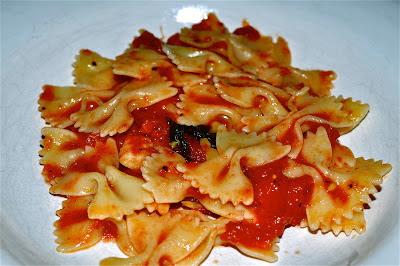I can't keep up with my tomatoes this year. A dozen plants have produced hundreds of tomatoes, and the season isn't over yet
They're everywhere, I swear.
These red and yellow things are also inside my head, and in a big way. Just the other night, as I stuffed a lamb leg and sipped on a sparkling
rosato, the mountain of just-picked Big Beefs and Sungolds seemed to command me to rethink the evening's dinner plans.
"Maybe you ought to do something with
us tonight," is about the gist of what I thought I had heard voices saying. "Fer chrissakes, Meatball. Lamb?
Really?"
"Okay, okay, pipe down," I said (aloud, yeah; I get that way around ripe fruit sometimes). "You look like you'd make a real nice risotto. Some of you do anyway."
And they did.
In fact, I encourage all of you fresh summer tomato lovers out there (you know who you are) to get on this risotto while there's still time. It is not my recipe. (My hands were full with the lamb course, remember?) The risotto was crafted by a very able associate of mine, and be assured that it (like the person who prepared it) is top notch.
Trust me on this.
Fresh tomato risotto
Recipe
6 Tbsp. butter, divided
1 Tbsp olive oil
4 shallots, sliced
1-1/2 cups Carnoroli or Arborio rice
1 cup white wine
2 medium-size ripe tomatoes, chopped
4 cups chicken stock, or as needed
Salt and pepper, to taste
A handful of cherry tomatoes, preferably a mix of yellow and red, halved
A few mint leaves, torn into small pieces
Heat 4 Tbsp. of butter and the olive oil in a deep saute pan, and add the shallot; saute over medium-high heat until wilted and gently brown, about 5 minutes.
Add the rice and toss to coat in the oil and onions; continue cooking over medium-high heat until the outer coating of the rice becomes slightly transparent, about 4-5 minutes.
Turn up the heat slightly and add the wine; cook for a few minutes until the wine is absorbed. Add the tomatoes, chopping and tossing with a wooden spoon, until they are pulpy.
Reduce the heat to medium and begin adding the stock, about 3/4 cup at a time, and cook, stirring, until the rice absorbs almost all of the stock. Continue adding stock and stirring, until the rice is almost al dente, about 18-20 minutes. Regulate the heat so that the stock is absorbed, rather than cooking off.
Taste the rice for seasoning and add salt and pepper to taste. Turn off the heat, stir in the cherry tomatoes and mint, then add the final 2 Tbsp. of butter and stir vigorously to incorporate the butter throughout the rice.
Serves 4-6






































